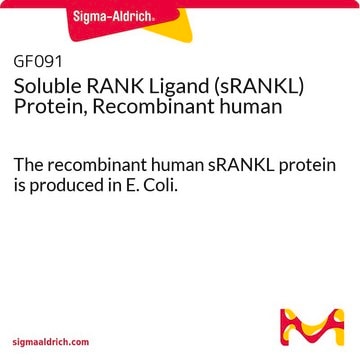SRP3160
sRank Receptor human
recombinant, expressed in E. coli, ≥98% (SDS-PAGE), ≥98% (HPLC), suitable for cell culture
Sinônimo(s):
ODAR (osteoclast differentiation and activation receptor), TNFRSF11A, TRANCE Receptor
Selecione um tamanho
Selecione um tamanho
About This Item
Produtos recomendados
fonte biológica
human
recombinante
expressed in E. coli
Ensaio
≥98% (HPLC)
≥98% (SDS-PAGE)
Formulário
lyophilized
potência
30-50 ng/mL ED50
peso molecular
19.3 kDa
embalagem
pkg of 100 μg
técnica(s)
cell culture | mammalian: suitable
Impurezas
<0.1 EU/μg endotoxin, tested
cor
white
nº de adesão UniProt
Condições de expedição
wet ice
temperatura de armazenamento
−20°C
Informações sobre genes
human ... TNFRSF11A(8792)
Descrição geral
Ações bioquímicas/fisiológicas
Sequência
forma física
Reconstituição
Código de classe de armazenamento
11 - Combustible Solids
Classe de risco de água (WGK)
WGK 3
Ponto de fulgor (°F)
Not applicable
Ponto de fulgor (°C)
Not applicable
Escolha uma das versões mais recentes:
Certificados de análise (COA)
Não está vendo a versão correta?
Se precisar de uma versão específica, você pode procurar um certificado específico pelo número do lote ou da remessa.
Já possui este produto?
Encontre a documentação dos produtos que você adquiriu recentemente na biblioteca de documentos.
Active Filters
Nossa equipe de cientistas tem experiência em todas as áreas de pesquisa, incluindo Life Sciences, ciência de materiais, síntese química, cromatografia, química analítica e muitas outras.
Entre em contato com a assistência técnica







